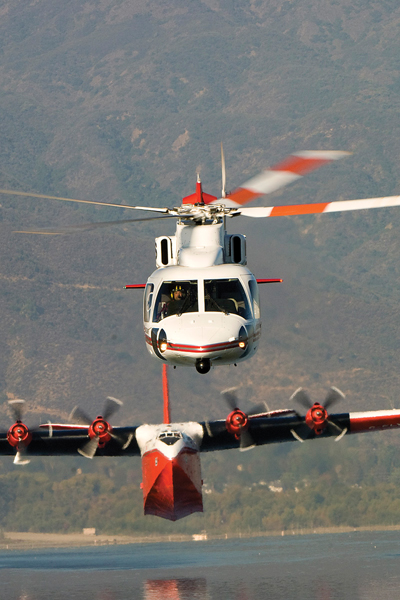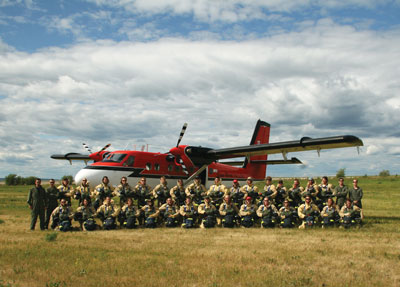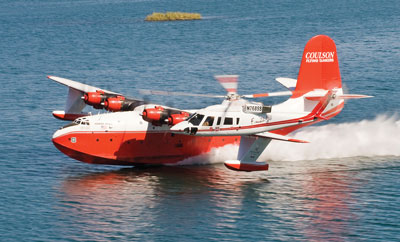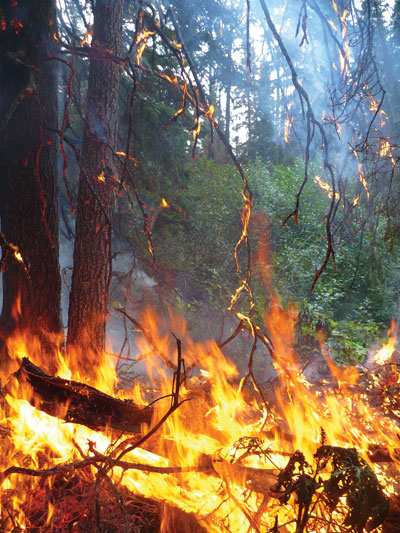
Features
Operations
Firing on all cylinders
Every year, on average, 8,500 wildfires are reported across Canada, burning an area of 2.5 million hectares.
May 9, 2011 By Paul Dixon
Every year, on average, 8,500 wildfires are reported across Canada, burning an area of 2.5 million hectares. Wildfires destroy property, cause economic hardship and generally disrupt lives. Over the past 10 years, the direct costs of fighting wildfires in Canada has ranged between $400 million and $800 million each year.
 |
|
| An integrated approach with both fixed- and rotary-winged assets helps keep B.C.’s fires at bay. Here, a Martin Mars water bomber accompanies a Sikorsky S-76B Firewatch helicopter. PHOTO: Coulson
|
Canada has developed a sophisticated management system to manage wildland firefighting response from the smallest isolated communities to international response. At the bottom rung, firefighting response within organized territory is the responsibility of the local authority: towns, cities, regional districts. If the situation is beyond their capabilities and/or resources, they may turn to neighbouring communities by way of mutual-aid agreements or to their provincial authority. All provincial and territorial governments have a forest protection agency. When the province’s resources are overwhelmed, the Canadian Interagency Forest Fire Centre (CIFFC) steps into the picture.
Located in Winnipeg, CIFFC co-ordinates services for all the provinces, territories and federal fire-management agencies, and co-ordinates sharing of resources with the United States and other countries. Funding for CIFFC is a federal-provincial joint venture, with the federal government contributing one-third and the provinces making up the remainder based on their inventory of productive forestland. British Columbia pays 17 per cent of that two-thirds, while Prince Edward Island pays only 0.1 per cent.
In 2010, the CIFFC processed 130 Resource Request Orders (RRO), which resulted in 26 water bombers, six air tankers and almost 2,500 firefighters, with their equipment being shared across the country.
While the terminology may be different from one province to the next, the philosophy of wildland firefighting is the same across the country – strike early, strike often, keep it small. Early detection of fires enables early dispatch of a co-ordinated response of ground and aerial resources. In British Columbia, the decision to deploy crews on any fire is made at one of six Regional Fire Centres located around the province by the Regional Wildfire Control Officer using the criteria of closest and/or most effective resource available to respond. Considerations for most effective use of a resource required to respond – or a combination of resources – include the size of the fire and burning conditions; any access issues (can you drive to it or is the fire remote?); dispatch distance; what is threatened (i.e., homes and infrastructure, high-value timber, etc.); and what is the current and predicted fire load within that Fire Centre’s region.
All about the team
British Columbia employs 1,100 Class 1 firefighters and 30 Initial Attack (IA) firefighters operating from 50 bases across the province. Three-person IA teams can be deployed by helicopter or vehicle. Salmon Arm is home to the province’s 36-member Rap attack team that rappels from helicopters to access fires in the heavily treed, steep mountain terrain, while Fort St. John in northern B.C. is home to the North Peace Smokejumpers, who operate out of fixed-wing aircraft.
 |
|
| The North Peace Smokejumpers, based in Fort St. John in northern B.C., pose in front of the Kenn Borek Air Twin Otter. Photo: Chris Bergmann |
The para-attack program operates with a single DeHavilland Twin Otter aircraft and Kenn Borek Air of Calgary provides pilots. Tom Reinboldt, the supervisor of the smokejumpers, describes the relationship between the pilots and his staff as “absolutely extraordinary. The pilots we work with are exceptional at understanding the nature of the job and our requirements.”
With an operational radius of more than 350 miles, the Twin Otter covers far more territory than a helicopter, flies faster and is able to “loiter” for much longer periods without refuelling. Its excellent short take-off and landing (STOL) capabilities enable it to operate from rough strips and forward bases that are inaccessible to larger aircraft, while its operational costs are measured in the hundreds of dollars an hour versus thousands of dollars an hour for a medium helicopter.
The aircraft carries the pilot, command spotter and two three-person teams of smokejumpers, as well as up to 1,400 pounds of firefighting gear, including two high-pressure pump kits, 4,600 feet of lightweight hose, chainsaws, overnight gear, food and water. Depending on the terrain and fire activity, the jumpers may have to land some distance from the fire. After reconnoitering the area around the fire to determine the best landing zone, the team leader will jump on the next pass. Once on the ground, the leader confirms the landing zone and the remaining two team members jump on the next pass.
Feet on the ground, the team forms up and heads for the fire. The plane will have dropped the equipment closer to the fire in a separate drop. At the same time the para-attack crew was dispatched, air tankers and/or helicopters may have been dispatched to the fire, depending on resource availability. Ideally, they will have the support of one or more tankers for retardant drops and helicopters for bucketing.
Hitting the fire so soon after ignition, the team strives to work around the fire, building a guard-line using chainsaws and hand tools, then their pumps and hose lines to effectively widen the guard line. Swift response by B.C.’s initial attack crews across the province keeps the team close to the goal of keeping 95 per cent of all wildfires under four hectares.
Last year was the busiest year for the smokejumpers since the inception of the program in 1998. Smokejumpers were deployed to more than 60 separate fires, for a total of more than 250 operational jumps. Over the past 12 years, the team has been deployed to more than 350 fires. And Reinholdt takes pride knowing no jumper has suffered a time-loss injury related to jumping in that time.
Aircraft support services
Unlike other provinces such as Alberta and Ontario, B.C. owns none of its own aircraft – part of the provincial government’s commitment to private-public partnerships. All aircraft are contracted, with a core group hired on a seasonal basis and others on an as-needed basis. At the peak of the 2009 fire season, there were 251 helicopters actively engaged in firefighting activities (57,000 hours flown), as well as 42 aerial tankers and water bombers.
 |
|
| The Martin Mars water bomber casts an iconic presence on the B.C. firefighting scene. PHOTO: Coulson
|
B.C.’s contracted tanker force comprises Air Spray’s Electras and Conair’s mixed fleet that ranges from single-engine Air Tractors to the four-engine Electra and DC-6. The B.C. Forest Service air tanker fleet command and control is the responsibility of the Provincial Air Tanker Centre, located in Kamloops. The centre dispatches the fixed-wing aerial firefighting resources from any one of the 18 Tanker Bases in the province.
When the Fire Centre dispatches on an initial report of a fire, multiple resources are sent simultaneously as part of a unified response, each with specific responsibilities. Helicopters bucketing water and foam, as well as tankers dropping retardant to contain the spread of the fire, will support initial attack firefighters on the ground. The philosophy, as explained by Jeff Berry, B.C.’s superintendent of air tanker operations, is simple enough. “Send enough resources to knock it down without a reload,” he says. The challenge is integrating the aerial response with the ground personnel, relating the resources to the event. It’s always easier to cancel a tanker en route when it’s not needed than to allow a situation to escalate by practising false economy and not dispatching.
Looking to the future
As the fleet of large air tankers ages, the challenge will be in sourcing replacement aircraft at affordable prices. Most current large air tankers are conversions of aircraft built in the 1950s, with more years behind them than in front of them. Bombardier has created a significant presence over the past 40 years with its CB-415 water bomber. To make the aircraft more attractive to governments, Bombardier markets it as a multi-dimensional platform, with the firefighting role just one of many potential tasks, including SAR and maritime reconnaisance.
 |
|
| More than 8,500 wildfires are reported across Canada each year, burning an area of 2.5 million hectares. PHOTO: Chris Bergmann |
The Very Large Air Tanker (VLAT) concept is being promoted as the future of aerial firefighting, with two American companies attempting to create a market. California’s Tanker Air Carrier operates two converted DC-10 aircraft (Tanker 910 and 911), and is capable of delivering 40,000 litres of product, while Oregon’s Evergreen Aviation International operates a 747 with a capacity of 75,000 litres. Tanker 910 first flew operations in California in 2006 for CALFIRE, the state wildfire agency, at an hourly rate of $26,500. The Evergreen 747 made its operational debut in 2009 in Cuenca, Spain.
Following the disastrous wildfires of 2009, in which 170 people died, the government of the Australian state of Victoria leased Tanker 910 for a 10-week operational trial during the 2009/10 fire season. The aircraft made only one actual operational drop during that period, and a number of evaluation drops. The question, as articulated by Richard Alder, general manager of Australia’s National Aerial Firefighting Centre, is whether “a single 40,000-litre drop can be as effective as 10 4,000-litre drops.” A report issued by Australia’s Bushfire Co-operative Centre concluded “such an aircraft is not suitable for effectively suppressing fires under most Australian wildfire conditions” and that the drops from the DC-10 were found to have “limited effectiveness” during the trial.
After spending $10.5 million on the DC-10 trial in 2010, the Victoria government is conducting trials this year with two CV-580 aircraft operated by Abbottsford, B.C.-based Conair. The cost of the CV-580s, an additional Sikorsky Skycrane and four additional Air Tractors will total $12 million, versus the cost of the single DC-10. The CV-580s carry an 8,000-litre payload at speeds of up to 500 kilometres per hour, but their manoeuvrabilty and proven record in Canadian operations should put them more in sync with Australian firefighting techniques. If the trial proves succesful, it may be a prelude to Canadian fixed-wing operators joining Canadian rotary-wing operators operating Down Under during the busy fire season.
| Martin Mars: 50 years on the job
The red and white giant Martin Mars water bombers are icons in the sky in B.C. Originally conceived as long-range bombers and maritime patrol aircraft for the U.S. navy in the Second World War, they served as long-range transports when their heavy-lift capability became apparent. Twenty had been ordered, but only seven were actually built before the war ended in 1945. In 1949, the Caroline Mars set a record by carrying 269 people between San Diego and Alameda, Calif., a distance of almost 800 kilometres. Until 1956, when they were retired from active service, the planes were employed carrying military cargo between San Francisco and Hawaii. In 1959, hearing that the planes were going to be scrapped, Dan McIvor, representing a consortium of Vancouver Island forestry companies, purchased the remaining four planes under the ownership of Flying Tankers, Inc. and they were converted to aerial firefighters. The Marianas Mars crashed on its first operational mission in 1961, killing all four crew members and the CarolineMars was destroyed on land during a severe storm in 1962. Since then, Hawaii Mars and Philippine Mars have flown thousands of incident-free hours. In 2007, the planes were sold to Coulson Forest Products of Port Alberni, leading to the creation of Coulson Flying Tankers. After purchasing the Mars, Coulson made significant upgrades to the Hawaii Mars including an EFIS glass cockpit and the ability to stream live data from on board. Other forms of data that are available from the aircraft in real time are Flight Tracking, Load Data measuring, Aircraft Performance statistics, Atmospheric Condition at Drop readings, and Accurate Drop Location reporting. Coulson operates its S-76B Firewatch helicopter, loaded with the complementary data systems, as the bird dog for the Mars. Coulson has been operating the Hawaii Mars in both B.C. and California over the past four years and will be in the air over B.C. for the summer of 2011. Dan McIvor, who passed away in 2005, received the Order Of Canada in 2003 for having “developed water bombing techniques that have saved thousands of acres of forest in British Columbia.” He is in the B.C. and Canadian Aviation Halls of Fame. |